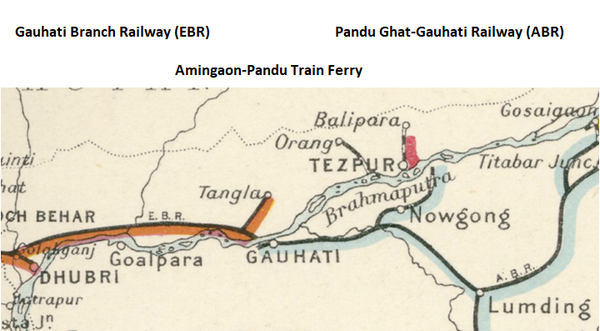| The Families In British India Society (FIBIS) is a self-help organisation devoted to members researching their British India family history and the background against which their ancestors led their lives in India under British rule. Let FIBIS help you break down those brick walls in your research |
Amingaon-Pandu Train Ferry

Amingaon-Pandu Train Ferry was the Eastern Bengal Railway (EBR) operation of rail transhipment by ferry crossing the Brahmaputra River between Amingaon and Pandu Ghat.
This ferry formed part of EBR ‘Gauhati Branch Railway metre gauge(MG) line of 147 miles (235km), opened 1909, from the EBR main line at Golakganj to the ferry terminus at Amingaoan .
From the ferry terminus at Pandu Ghat the short ‘Pandu Ghat-Gauhati Railway’ ran to Gauhati.where the line connected to the Assam-Bengal Railway(ABR) . This short link was constructed by the EBR opened c.1908 and linked to the metre gauge(MG) ABR network. The line was worked by ABR and transferred to ABR, 1922
Proposals were made during World War 2 to build a bridge at the ferry during the war were considered but the time it would take (2 years) did not make it feasible. ‘The Amingaon - Pandu train ferry across the mile wide Brahmaputra was a bottleneck in the metre-gauge rail system serving the British-Indian 14th Army Central Front Manipur Road railhead at Dimapur and the American/Chinese Front railhead at Ledo.
It was only in 1962 that the Saraighat Bridge replaced the ferry service[1],this is post independence and beyond the scope of this page.
Description of Transhipment
A fascinating 1943 account of the process of transhipment is given in ‘Marching on to Laffan’s Plain’ by Alan Shaw, Chapter 10 [2].
The Amingaon-Pandu train ferry across the mile wide Brahmaputra was a bottleneck in the metre-gauge rail system serving the British-Indian 14th Army Central Front Manipur Road railhead at Dimapur and the American/Chinese Front railhead at Ledo.
“...the final approach of the railway line to the Amingaon ‘Ghat’, or ferry loading point, was hazardous. Here the Brahmaputra was about a mile wide. ...... The train had been disconnected and remarshalled. I was now at the front end of a train of four wagons, with a snorting locomotive bringing up the rear and pushing us forward in determined fashion.
I
” had an alarming grand stand view of a hundred yards of track running ahead supported on timber cribwork over a muddy beach a long way below. If all went well my wagon and one other would finish up on a short length of rails straddling a barge, side by side with several others. Visible nearby were two or three wagons half submerged in the mud, mute testimony to the occasional fallibility of the system.”
“The casual-looking timber cribwork structure was in an almost continual state of adjustment by hard working gangs of labourers, deftly removing or inserting the timber baulks to adjust the height and slope of the railway line according to the water level and changes in the river bed. It was an engineer’s nightmare but also a tribute to their skill.”
”This ferry transhipped up to 250 wagons per day in each direction, representing over 50 per cent of the total supply requirement for the Central and Northern fronts at that time. The capacity was later trebled. When loaded each pair of barges would be lashed either side of a steam tugboat and sailed across to the Pandu Ghat on the south bank, two miles from Gauhati.”
References
- ↑ Wikipedia ‘Saraighat’ ; Retrieved 3 June 2020
- ↑ "Marching on to Laffan’s Plain"’ by Alan Shaw, Chapter 10A from the BBC archives; Retrieved 3 June 2020